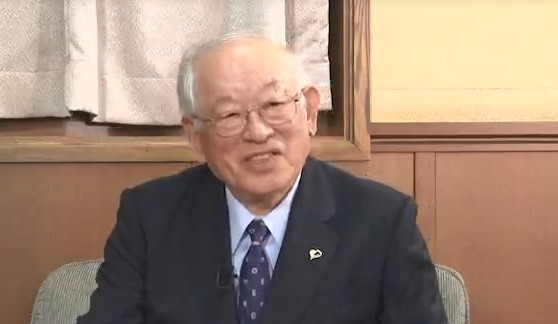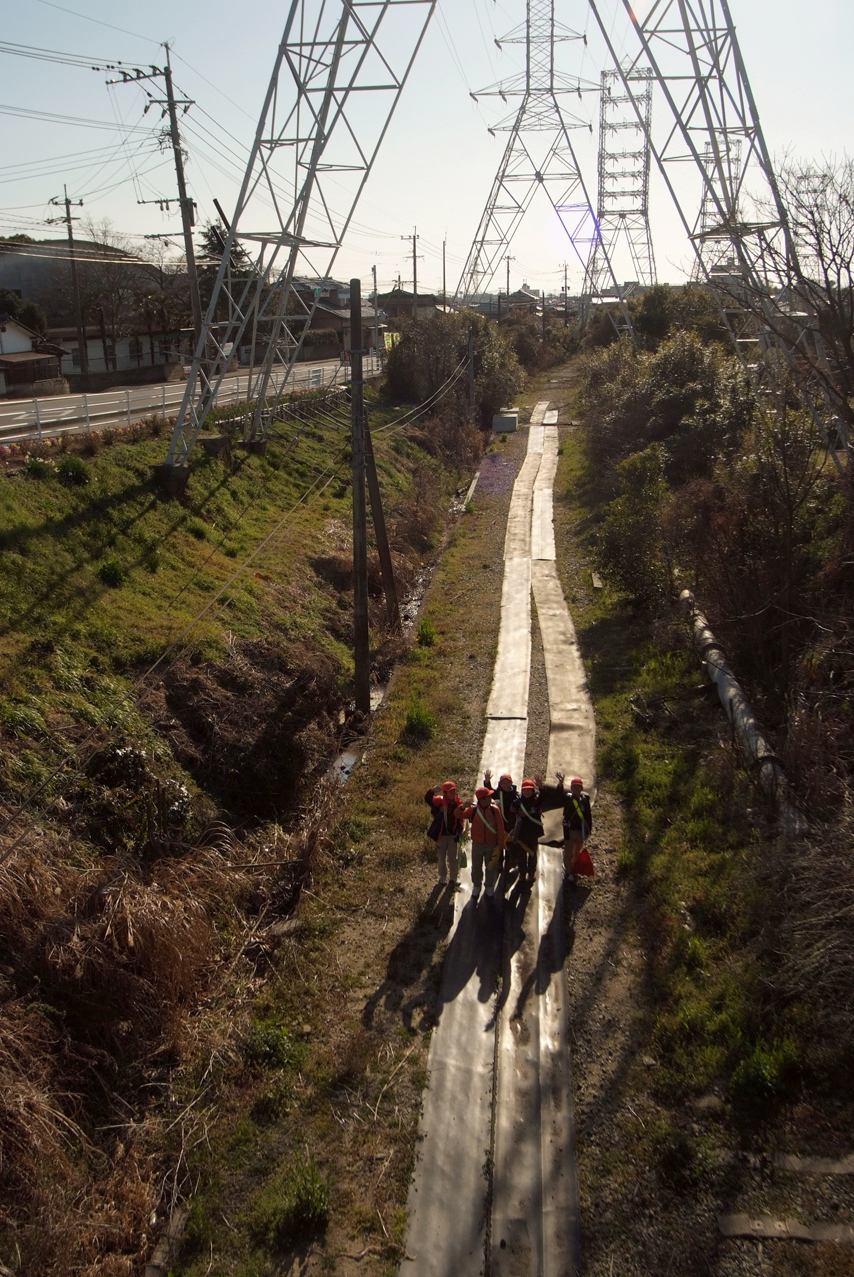PEOPLE
Former Mayor of Omuta City

Koga: Afterwards, Ms. Kato gave an order to Vice-Minister Hirano, saying, "Let's all make this request together." I went to the Ministry, where many prominent people from the business world, including the presidents of the chambers of commerce and industry of Fukuoka City and Kitakyushu City, were present. At the time, the Port of Miike had to be developed as part of the measures to prevent the closure of the port, and there were many plans to deepen and expand the bay from 8 to 10 metres to allow large ships to enter, to repair the quay walls and to install cranes. However, unfortunately, none of this would move ahead if the port was a cultural property.
Kato: The working guideline of the World Heritage Convention does not say to preserve values under the Law for the Protection of Cultural Property. The values that we wanted to preserve were to preserve the function of the port as a living, active industrial port, to preserve it as it is, so the only way to go about that was through utilising the Port and Harbour Law system.
Koga: At that time, there were many different faces from various business circles and local dignitaries, but everyone was united, and it led to a powerful moment where we were able to explain Ms. Kato's proposal to Vice-Minister Hirano.
It would not have been possible to come up with the idea from within the government office alone. Furthermore, Mr. Makoto Koga did not have a good reaction at first, but every time he made a report, progress was made, so he cooperated towards the end. In the end, he said, "Okay, I will arrange the matter."
Kato: I appreciate that. That is how everyone supported me. I also visited Mr. Koga to explain the project, and since he was very attached to the Port of Miike, he immediately understood. It is nice to have the support of a teacher who understands the local community.
Koga: He was once Minister of Transport. At that time, he was in charge of the Port of Miike after the closure of the mine and was involved in its maintenance. Mr. Koga was a highway tribe (one of the politicians who support highway construction interests), and he told me that “compared to the budget for roads, the budget for port development was tiny and that if we spent a little more money, we could build a great port.”
Kato: Therefore, it took more than 13 years of turbulent days, but Miike made the most significant breakthrough. Once, a person from the Ministry of Economy, Trade and Industry came to Omuta. When he went to the UK with the Governors' Association, there was a talk about cutting the operating assets. This was despite the Cabinet’s decision to go with a new framework. At that time, Lord Cossons did his best. He told us we needed all the operating assets, including Nagasaki Heavy Industries.
Koga: When you visited the UK, the schedule was postponed, wasn't it? I could not go because I was busy with the Parliament and other things when it was postponed. The deputy mayor went in my place, but I heard from him that there was an incident (laughs).
Kato: Yes, there was an incident. The Deputy Chief Cabinet Secretary worked with the Agency for Cultural Affairs Commissioner to turn it over once more. It was at that point that there was talk of putting it back into the cultural property framework again. Hence, if we had removed all the operating assets, we would not have been able to register them after all. That is how much the Agency for Cultural Affairs wanted only to recommend assets from the end of the Edo period. If they had done that, all of Fukuoka would have fallen.
Koga: Well, if that had happened, it would not have become a World Heritage Site. It can't be a serial heritage site, after all. After that, you submitted a written request to Chief Cabinet Secretary Suga. At that time, it was already in the Port and Harbour Law framework.
Kato: So, it took much work to get a Cabinet decision once then. But you were able to register because you did not waver, right, Mr. Koga?
Koga: I wanted to make the Port of Miike a World Heritage Site, so Nippon Coke Co., Ltd. and Miike Port Logistics Co., Ltd. had their minds set on it as well. Still, the governor of Nagasaki must have had a headache at that time especially since the hidden Christians were more in favour of the project.
Kato: At the time of the council meeting, only the Governor of Nagasaki was 'against' the idea. Even though Nagasaki has eight component parts, the prefectural and city council were unanimously against it.
Koga: However, they did issue a supplementary opinion. I heard that there was an opinion that Nagasaki wanted what the Hidden Christians favoured to proceed instead. That is stated in the request, is it not?
Kato: Even though it is an absolute requirement that all the local authorities recommend the project, Mr. Abe has made it possible to jump over that line. Despite requests from Nagasaki Prefecture and the city of Nagasaki for Mitsubishi to back down, when I told Mr. Abe that Mitsubishi's policy was that if the national government did not waver, it would be fine, he said I see, and he understood. Mr. Abe was amazing in that way.
Koga: The international conference was also great—about 4 000 people came, and the main hall of the Hotel Okura was full. Many of them came from Omuta.
Kato: Thank you very much for that time. I had everyone there to air all their opinions. That was a big challenge for me. I invited various people from around the world and had foreign experts visit the site and understand its historical value, and it was like laying the groundwork for a public opinion campaign.
Koga: Nobody imagined that Prime Minister Abe would come, so the audience was very excited.
Kato: It was through a series of things like that that we were able to fight together and make it this far. I am sorry to be presumptuous; Mr. Abe was like a comrade-in-arms. By the way, I came here today from the Ariake Coastal Highway and wished there were more World Heritage signs along the road. We need to ask the maintenance bureau to do that. The Ariake Coastal Highway can be accessed here from the ruins of the Miezu Naval Station in Saga, and Miike is more accessible from Saga Airport.
Koga: There were more signs when the site became a World Heritage Site. Indeed, thanks to the Ariake Coastal Highway, Omuta and Saga are now closer.
Kato: The traces of history, the good and the bad remain intact in Miike, which makes it a region with a deep flavour. However, it is sad that trains of Mitsui Chemicals are gone. The image of Mitsui is fading away.
Koga: The last of the Miike railway line is gone. Rail transport is too costly. I would like to see the Port of Miike used more.
Thank you very much for your time today.

Representative Director, National Congress of Industrial Heritage
(Honorary Advisor, Kyushu Railway Company (JR Kyushu)
Senior Researcher, Industrial Heritage Information Centre
Honorary Advisor, Nippon Mining Co., Ltd.
The Ambassador of Supporting Kamaishi Hometown
Former Director of Nagasaki City World Heritage Office
Former General Manager, Nagasaki Shipyard and Machinery Works, Mitsubishi Heavy Industries, Ltd.
Chairman, Fujisankei Group
Executive Managing Advisor, Fuji Television Network, Inc.
Executive Managing Advisor, Fuji Media Holdings, Inc.
Advisor, Federation of Japan Port and Airport Construction Association
(Ex. Chairman of Specialists Center of Port and Airport Engineering)
Mayor of Nagasaki City
Former Director of the Sano Tsunetami Memorial Museum (currently known as Sano Tsunetami and the Mietsu Naval Dock History Museum)
Director of NPO Association for Thinking about Satoyama
Director of National Congress of the Industrial Heritage
Honorary Chief Priest Toshinari Ueda
Former Mayor of Omuta City
Archaeologist and Heritage Conservation Specialist
A fellow of the Japan Federation of Engineering Societies
Team Member of the Industrial Project Team Office for the Promotion of World Heritage Listing under Cabinet Secretariat
Governor of Kagoshima Prefecture
Mayor of Hagi City
Mayor of Uki City, Kumamoto Prefecture
The Former Employee of Nippon Steel Corporation
An Associate Professor of the Faculty of Science and Engineering in Iwate University
Chairman of the Tourist Guide Association of Misumi West Port
President of Kuraya Narusawa Co., Ltd.
Chairman of Izunokuni City Tourism Association
Director and General Manager of Gunkanjima Concierge
Producer of the Gunkanjima Digital Museum
Owner at Tōge Chaya
Chairman: Mr. Hidenori Date
President: Mr. Masahiro Date
Proprietor, Houraikan Inn
Representative Director of Egawa Bunko non-profit incorporated foundation
The 42nd head of the Egawa Family
Democratic Party for the People (DPP) Representative for Nagasaki Prefecture
President of the NPO, Way to World Heritage Gunkanjima
Representative Director
MI Consulting Group
President of Watanabe Production Group and Honorary Chair of Watanabe Productions Co., Ltd.
Member of the House of Councillors
Governor
Kagoshima Prefecture
World Heritage Consultant
Director and Dean, The Kyushu-Asia Institute of Leadership
Representative Director, SUMIDA, Inc.
Journalist, founder of the Shimomura Mitsuko Ikikata Juku School
Representative, Rally Nippon
Chairman, Sites of Japan’s Meiji Industrial Revolution World Heritage Route Promotion Council Director, National Congress of Industrial Heritage
Representative Director, General Incorporated Foundation National Congress of Industrial Heritage (Advisor, Public Interest Incorporated Foundation Capital Markets Research Institute)
Mayor of Nagasaki City
Policy Director at Heritage Montreal
World Heritage Consultant
Executive Director of Kogakuin University
Heritage Architect and International Consultant
Head of Data Acquisition at The Glasgow School of Art’s School of Simulation and Visualisation
Head of Industrial Heritage, Historic Environment Scotland, Edinburgh
Scottish Ten Project Manager, Historic Environment Scotland, Edinburgh
Mayor of Izunokuni City, Shizuoka Prefecture
Pro-Provost and Chairman of Council of the Royal College of Art. Heritage advisor of Canal & River Trust for England and Wales.
Dean of Tokyo Rissho Junior College
Professor emeritus of Keio University
Mayor of Kitakyushu City
At the 39th session of the World Heritage Committee convened in Bonn, Germany, from June 28 to July 8, 2015, the decision was approved to inscribe the Sites of Japan’s Meiji Industrial Revolution on the World Heritage list.
At a celebratory party held to mark the occasion, some of the primary promoters of the project spoke of their joy in achieving their goal and of the trials and tribulations to getting there.
Director and Managing Executive Officer, Hanshin Expressway Company Limited
Member, Board of Directors, National Congress of Industrial Heritage
Vice-Governor of Shizuoka Prefecture
Mayor of Hagi City
Chairman, Tokyo Metro Co., Ltd.
Mayor of Omuta City
Deputy Director-General, Lifelong Learning Policy Bureau, MEXT
Former Counsellor, Cabinet Secretariat
Mayor of Kamaishi City
Member, Board of Directors, National Congress of Industrial Heritage Counselor, Shimadzu Limited
Chairman of the Consortium for the World Heritage Inscription of Modern Industrial Heritage (Kyushu-Yamaguchi) and governor of Kagoshima Prefecture (as of 2015)